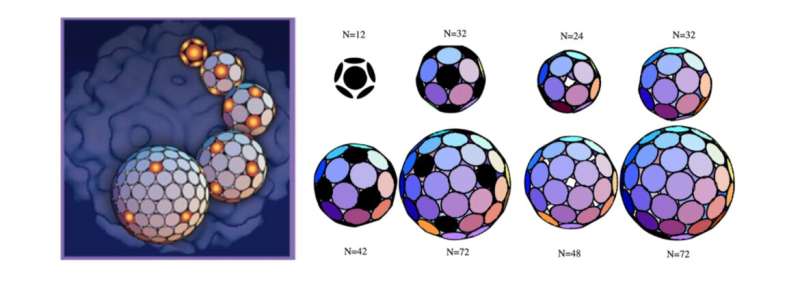How a virus forms its symmetric shells

Viruses—small disease-causing parasites that can infect all types of life forms—have been well studied, but many mysteries linger. One such mystery is how a spherical virus circumvents energy barriers to form symmetric shells.
A research team led by physicist Roya Zandi at the University of California, Riverside, has made progress is solving this mystery. The team reports in a paper published in ACS Nano that an interplay of energies at the molecular level makes the formation of a shell possible.
Understanding the factors that contribute to viral assembly could enable biomedical attempts to block viral replication and infection. A better understanding of how viral shells—nature's nano-containers—form is of vital importance to material scientists and a crucial step in the design of engineered nano-shells that could serve as vehicles for delivering drugs to specific targets in the body.
Zandi's team explored the role of protein concentration and elastic energy in the self-organization of proteins on the curved shell surface to understand how a virus circumvents many energy barriers.
"Understanding the combined effect of elastic energy, genome-protein interaction, and protein concentration in the viral assembly constitutes the breakthrough of our work," said Zandi, a professor in the Department of Physics and Astronomy. "Our study shows that if a messy shell forms because of the high protein concentration or strong attractive interaction, then, as the shell grows larger, the cost of elastic energy becomes so high that several bonds can get broken, resulting in the disassembly and subsequent reassembly of a symmetric shell."
What is a virus?
The simplest physical object in biology, a virus consists of a protein shell called the capsid, which protects its nucleic acid genome—RNA or DNA. Viruses can be thought of as mobile containers of RNA or DNA that insert their genetic material into living cells. They then take over the cells' reproductive machinery to reproduce their own genome and capsid.
Capsid formation is one of the most crucial steps in the process of viral infection. The capsid can be cylindrical or conical in shape, but more commonly it assumes an icosahedral structure, like a soccer ball.
An icosahedron is a geometrical structure with 12 vertices, 20 faces, and 30 sides. An official soccer ball is a kind of icosahedron called a truncated icosahedron; it has 32 panels cut into the shape of 20 hexagons and 12 pentagons, with the pentagons separated from each other by hexagons.
Viral assembly is not well understood because viruses are very small, measuring in nanometers, a nanometer being one-billionth of a meter. The assembly also happens very quickly, typically in milliseconds, a millisecond being one-thousandth of a second. Theoretical work and simulations are necessary to understand how a virus grows.
"A viral shell is highly symmetric," Zandi said. "If one pentagonal defect forms in the wrong location, it breaks down the symmetry. Despite this sensitivity, viral shells are often assembled into well-defined symmetric structures."
Nano vehicles
Zandi explained that due to a lack of experimental data, the virus assembly process is not well understood. The new work found the elastic properties of capsid proteins and the attractive interaction between them go hand in hand to form highly symmetric configurations that are energetically very stable.
"By fine-tuning these parameters, we can control the final structure and stability of viral capsids," she said. "These viral capsids can be used as nano-containers for transporting drugs as cargo to specific targets. What makes them highly promising for drug delivery and gene delivery purposes is that they are stable, have a high uptake efficiency, and have low toxicity."
Already, some experimental groups are working with pharmaceutical companies to design drugs that interfere or block viral assembly. Her lab is working with international collaborators to design simulations to better understand virus assembly.
"Understanding the factors that affect the stability of the final viral structures can make drug delivery processes more controllable," she said.
More information: Sanaz Panahandeh et al, How a Virus Circumvents Energy Barriers to Form Symmetric Shells, ACS Nano (2020). DOI: 10.1021/acsnano.9b08354
Journal information: ACS Nano
Provided by University of California - Riverside




















